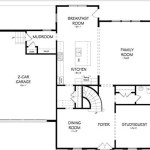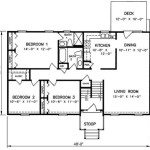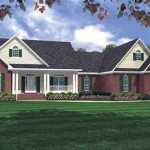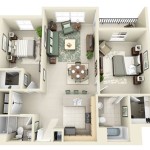L-Shaped Ranch House Plans: Design, Advantages, and Considerations
The L-shaped ranch house plan represents a popular and versatile architectural style. Characterized by its single-story layout and distinctive L-shaped footprint, this design offers a blend of functionality, aesthetic appeal, and adaptability to various site conditions. This article will examine the key aspects of L-shaped ranch house plans, exploring their advantages, design considerations, and elements contributing to their enduring popularity.
The ranch-style house, particularly in its L-shaped configuration, gained prominence in post-World War II America. The single-story design catered to a growing suburban population seeking comfortable and accessible living spaces. The L-shape allowed for a natural separation of living and sleeping areas while maximizing exposure to sunlight and outdoor views. Over time, the design has evolved to incorporate modern features and accommodate contemporary lifestyles, retaining its core principles of spaciousness and convenience.
Key Advantages of L-Shaped Ranch House Plans
The L-shaped ranch house offers several benefits that contribute to its ongoing appeal. These advantages extend beyond aesthetics, encompassing practical aspects of living and construction.
One major advantage is the natural zoning created by the L-shape. One wing can house the bedrooms and bathrooms, offering a private retreat for family members. The other wing typically contains the living room, dining area, and kitchen, creating a central hub for social interaction and daily activities. This separation helps to minimize noise transfer and provides a sense of privacy within the home.
Another significant benefit is the potential for enhanced natural light and ventilation. The two wings of the house create multiple exterior walls, increasing the opportunity for windows and doors. This design allows for cross-ventilation and abundant natural light to penetrate different parts of the home throughout the day. Properly oriented, the L-shape can also help to capture prevailing breezes, reducing the need for artificial cooling.
The L-shaped design often lends itself well to optimizing outdoor living spaces. The angle created by the two wings can form a sheltered courtyard or patio area, providing a private and protected space for relaxation and entertainment. This outdoor space can be seamlessly integrated with the interior living areas, blurring the boundaries between indoors and outdoors. It can also be customized with features like a swimming pool, garden, or outdoor kitchen.
Furthermore, the single-story design of the ranch style offers accessibility for individuals of all ages and abilities. The absence of stairs eliminates a common barrier to mobility, making the home suitable for families with young children, elderly residents, or individuals with physical limitations. This eliminates safety concerns related to stairs and offers greater ease of movement throughout the home.
Finally, from a construction standpoint, the L-shaped ranch can be relatively straightforward to build. The single-story design simplifies the foundation and roofing processes compared to multi-story structures. The layout is easily adapted to modular construction, potentially reducing construction time and costs. The design can also be readily customized to suit the homeowner’s specific needs and preferences.
Design Considerations for L-Shaped Ranch House Plans
Designing an L-shaped ranch house requires careful consideration of several factors to maximize its functionality and aesthetic appeal. These considerations include site orientation, interior layout, and material selection.
Site orientation plays a crucial role in determining the overall energy efficiency and comfort of the home. The L-shape should be positioned to take advantage of natural sunlight and prevailing winds. In cooler climates, orienting the longer side of the "L" towards the south can maximize solar heat gain. In warmer climates, orienting the house to minimize solar exposure and maximize ventilation can help to reduce cooling costs. The placement of windows and doors should also be carefully considered to optimize natural light and ventilation while minimizing heat loss or gain.
The interior layout should be carefully planned to ensure a functional and comfortable living space. The separation of living and sleeping areas is a key benefit of the L-shape, and this should be reflected in the layout. The living areas should be spacious and well-lit, with ample room for socializing and entertaining. The bedrooms should be located in a quieter area of the house, away from the main living areas. The kitchen should be centrally located and easily accessible from both the living and dining areas.
Hallways should be minimized to maximize usable floor space. An open-concept design can be implemented in the living areas to create a sense of spaciousness and allow for easy flow between rooms. Storage space is also an important consideration. Closets, pantries, and other storage areas should be strategically located throughout the house to minimize clutter and maximize organization.
Material selection can significantly impact the aesthetic appeal and energy efficiency of the home. Exterior materials should be chosen to complement the surrounding environment and reflect the homeowner’s personal style. Common materials include brick, wood siding, stone veneer, and stucco. The choice of roofing materials can also impact the energy efficiency of the home. Light-colored roofing materials can reflect sunlight and reduce heat gain, while dark-colored materials can absorb heat and increase energy costs. Interior materials should be durable, easy to maintain, and aesthetically pleasing. Hardwood floors, tile, and carpeting are common choices for flooring materials. Walls can be painted in a variety of colors to create different moods and atmospheres.
Furthermore, attention must be paid to the roof design. Ranch houses traditionally feature low-pitched roofs, often with wide eaves. These eaves provide shade and protect the exterior walls from the elements. The roof can be configured in various ways, including a gable roof, hip roof, or shed roof. The choice of roof design can impact the overall aesthetic of the home and the amount of attic space available.
Variations and Modern Adaptations of L-Shaped Ranch House Plans
While the basic L-shaped ranch house plan remains popular, numerous variations and modern adaptations have emerged to cater to diverse tastes and lifestyles. These adaptations often involve incorporating contemporary features and technologies while retaining the core principles of the ranch style.
One common adaptation is the addition of a second story or finished basement. While the traditional ranch is single-story, some homeowners opt to add a second story above one wing of the house or finish the basement to create additional living space. This can be particularly useful for growing families or those who need extra bedrooms, a home office, or a recreation room.
Another adaptation is the integration of modern building materials and technologies. Energy-efficient windows, insulation, and HVAC systems can significantly reduce energy consumption and improve indoor air quality. Smart home technology can automate lighting, temperature control, and security systems, enhancing convenience and comfort. Sustainable building materials, such as reclaimed wood and recycled content, can be used to minimize the environmental impact of the home.
Modern L-shaped ranch houses often feature open-concept living spaces that seamlessly blend the living room, dining area, and kitchen. This design creates a more spacious and social atmosphere, ideal for entertaining and family gatherings. Large windows and sliding glass doors connect the interior living spaces with the outdoor areas, blurring the boundaries between indoors and outdoors.
The integration of universal design principles is another important trend in modern L-shaped ranch houses. Universal design aims to create homes that are accessible and usable by people of all ages and abilities. This includes features such as wide doorways, grab bars in bathrooms, and lever handles on doors. These features make the home more comfortable and convenient for everyone, regardless of their physical abilities.
Finally, customization is a key aspect of modern L-shaped ranch house plans. Homeowners can work with architects and builders to create a design that perfectly suits their individual needs and preferences. This includes choosing the layout, materials, finishes, and features that reflect their personal style and enhance their lifestyle. The flexibility of the L-shaped design allows for a wide range of customizations, from simple modifications to complete transformations.
In conclusion, the L-shaped ranch house plan offers a versatile and appealing option for homeowners seeking a comfortable, functional, and aesthetically pleasing single-story home. Its natural zoning, potential for enhanced natural light, adaptability to outdoor living, and accessibility make it a popular choice for a wide range of lifestyles. By carefully considering site orientation, interior layout, material selection, and modern adaptations, homeowners can create an L-shaped ranch house that perfectly meets their needs and reflects their personal style.

Modern C Shaped House L Ranch Plans Floor Best Design S

Ranch Style House Plan 3 Beds 5 Baths 3776 Sq Ft 888 17 Plans L Shaped

Ranch Style House Plan 3 Beds 2 Baths 2599 Sq Ft 436 1 Plans One Story L Shaped

10 Gorgeous Ranch House Plans Ideas L Shaped One Story

Ranch Style House Plan 2 Beds 5 Baths 2507 Sq Ft 888 Pool Plans L Shaped

Get Inspired For Open Concept Two Story L Shaped House Plans Garage

Parkside Ranch Home L Shaped House Plans Garage Courtyard

House Plan 2559 00147 Ranch 2 498 Square Feet 3 Bedrooms 5 Bathrooms L Shaped Plans

Why An L Shaped House Plan Makes The Best Home Design Monster Plans Blog

Beautiful Warner Style House Plan 6969 Plans Floor L Shaped








